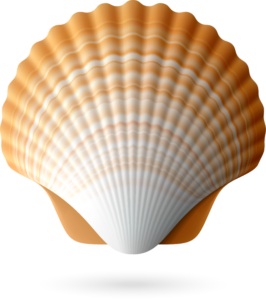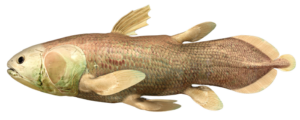Read the Following Selection
Read the following selection, or click on the play button below to listen aloud.
The Dinofish

The year was 1938. Marjorie Courtenay-Latimer was working in a tiny museum in the town of East London on the coast of South Africa. As part of her job, Marjorie collected natural objects such as shells, feathers, and rocks to display in the museum.
Marjorie thought it would be a good idea to add some unusual fish to the museum’s collection. She had alerted fishers in the area to let her know if they caught any unusual fish.
An Early Christmas Gift
On December 3, Marjorie got a phone call asking if she wanted to come to the docks to look at the fish that had been caught that day. Marjorie almost did not go. She was busy preparing a display of reptiles for the museum. Then she decided that, since it was getting close to Christmas, she would go to the docks just to wish the fishers a happy holiday.
Beautiful Fish
Down at the docks, Marjorie chatted with the fishers and wished them a merry Christmas. She was just about to leave when she happened to glance down at a pile of fish that had been unloaded from a boat. She noticed an unusual fin sticking out of the pile. Curious, she pushed aside the fish lying on top and saw what she described as “the most beautiful fish I had ever seen.” The fish was blue, about 1.5 m long, and had silver markings on its body. Marjorie had never seen a fish like that before. She wanted to preserve it to display in the museum.

Strange New Species
When she got back to the museum with the strange fish, Marjorie looked through books to try to identify it. Finally, she found a drawing of a fish called a coelacanth (say it like this: seel-uh-kanth) that looked very similar to the one she had found. There was just one problem—the coelacanth was known only from fossils. Scientists believed the fish had become extinct about 65 million years ago, around the same time that dinosaurs disappeared.
Exciting Discovery!
Marjorie made a quick drawing of the fish and sent it to James Smith, a fish expert she knew. He was away at the time but, on January 3, 1939, Marjorie got a telegram from him. James was very excited about Marjorie’s fish. He said he would travel to East London as soon as he could. He arrived at the museum on February 16 and confirmed that the fish really was a coelacanth.
Front Page News!
A newspaper reporter took a picture of the fish. Soon the picture appeared in newspapers around the world. Everyone was amazed that a fish people believed had died out millions of years ago had survived deep in the ocean. Marjorie became famous, and the coelacanth was called the most important animal discovery of the century.
Fun Facts
• After Marjorie’s discovery, a reward was offered to anyone who could catch a second coelacanth. Fourteen years passed before another coelacanth was caught.
• Coelacanths appear to stand on their head. They sometimes float with their head pointing down and their tail pointing up.
• Scientists believe that coelacanths live for about 60 years in the wild, although some may live much longer.
• There are only two species of coelacanths known to scientists. One species of coelacanth lives near the Comoro Islands off the east coast of Africa. Another species of coelacanth was found in the waters off Sulawesi, Indonesia.
• Coelacanths are considered an endangered species.
• Coelacanths live in depths up to 700 metres below the surface.
Now, show what you know!
Complete some questions about the reading selection by clicking “Begin Questions” below.









